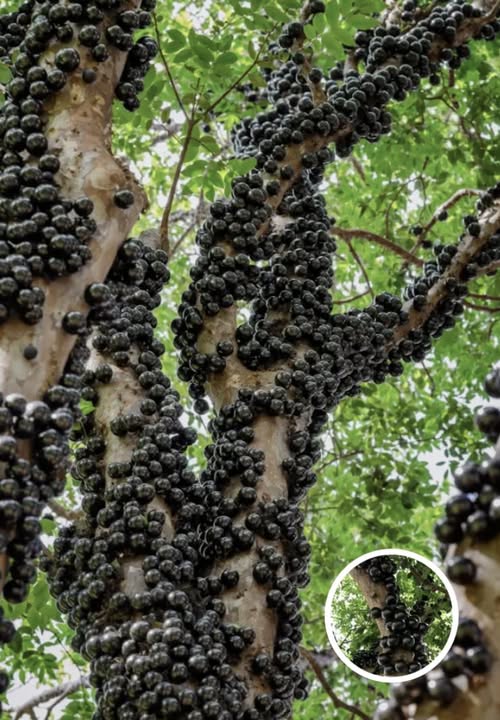On social media, images of a rare and unusual tree have left viewers around the world stunned. Unlike the apple or cherry trees we may be used to seeing in backyards, this South American wonder looks almost unreal at first glance. Instead of growing fruit on its branches, the jabuticaba tree, often called the Brazilian grape tree, produces clusters of deep purple fruit directly on its trunk.
The sight is so strange and beautiful that many people mistake the photos for digital art. But this tree is no illusion — it’s a real, living testament to nature’s ingenuity.
What Makes the Jabuticaba Tree So Unique?
The jabuticaba tree belongs to the Myrtaceae family and is native to Brazil, though related species are also found in Argentina, Paraguay, Bolivia, and Peru. It thrives in warm, humid climates and grows especially well in Brazilian states like Rio de Janeiro, São Paulo, and Goiás.
Family vacation packages
What makes the tree extraordinary is its unusual growth pattern known as cauliflory. Instead of fruit sprouting from stems or branches, the shiny, grape-like berries grow directly from the bark of the trunk and main limbs. When the tree is in full fruiting season, it can appear completely covered in dark purple or nearly black spheres, giving it an otherworldly look.
The fruits resemble grapes in size and color, but they are technically berries. Inside, the pulp is white and sweet with a slightly acidic tang, making them delicious to eat raw. Locals also use them to make jellies, jams, juices, liqueurs, and even wine.
The Cultural and Historical Significance
The word “jabuticaba” comes from the Tupi language, combining “jaboti” or “jabuti” (meaning tortoise) with “caba” (meaning place). This roughly translates to “the place where tortoises are found.” The fruit’s pale pulp has historically been compared to turtle fat, giving it a distinctive cultural association.
For generations, the jabuticaba tree has been more than just a food source. Families in Brazil often plant them in their yards, where children grow up climbing the trunks and plucking the ripe fruits straight from the bark. The trees have become woven into cultural memories and family traditions, making them both practical and sentimental treasures.
Best restaurants near me
Family vacation packages
Appearance and Growth Cycle
The jabuticaba tree’s leaves go through a striking transformation. When new, the leaves are salmon-colored, but as they mature, they darken into a rich green. The fruits themselves begin as light green globes that ripen to a deep purple-black, signaling they are ready for harvest.
The tree’s ripening cycle is rapid — the fruit matures within 20 to 25 days. This quick turnaround makes the jabuticaba a reliable source of fresh produce during its season, but it also means the fruit spoils quickly once harvested. To fully enjoy its unique flavor, it’s best eaten directly from the tree.
A Viral Sensation
Social media users have been captivated by photos and videos of the jabuticaba tree. Some posts show entire trunks coated so thickly with berries that the bark is barely visible. Comments flood in with admiration, curiosity, and even nostalgia.
One Facebook user shared the joy of seeing a jabuticaba tree in bloom while visiting Florida, where some enthusiasts have successfully cultivated them outside of South America. Another reminisced about climbing the trees as a child in Brazil, recalling how the sweet fruit tasted better when eaten fresh in the sunshine.
The tree has become something of a viral sensation, with people across the globe fascinated by the surreal appearance of “grapes growing out of wood.”
Nutritional and Medicinal Benefits
Beyond its striking look, the jabuticaba fruit is also highly nutritious. Rich in vitamin C, antioxidants, and anti-inflammatory compounds, it has been traditionally used in Brazilian folk medicine for centuries. Some studies suggest that jabuticaba may help support digestion, boost immunity, and even improve skin health.
Its antioxidant content has sparked interest in global health circles, with researchers exploring its potential role in fighting oxidative stress and chronic disease. Like many tropical fruits, it offers both sustenance and healing potential, reinforcing its importance in the regions where it grows naturally.
How the Fruit is Enjoyed
In Brazil, jabuticaba is eaten fresh whenever possible, since the fruit is highly perishable and begins to ferment shortly after being picked. Families gather around trees to snack on the berries straight from the trunk, often filling baskets for immediate use.
When harvested in larger amounts, the fruit is transformed into a variety of products. Jabuticaba jam is a household staple in some regions, while jabuticaba wine and liqueurs are enjoyed as local specialties. The fruit can also be turned into refreshing juices or syrups that capture its tart-sweet flavor.
Growing Jabuticaba Outside South America
Though native to Brazil, the jabuticaba tree has gained popularity among plant enthusiasts worldwide. It requires warm, humid conditions and plenty of water, which makes it challenging to grow in temperate climates. Still, dedicated gardeners in places like Florida and California have successfully cultivated the tree, often in greenhouses or specially designed gardens.
Because the fruit is so delicate and perishable, it is rarely exported internationally. This adds to its exotic allure — to truly taste a jabuticaba berry, most people must travel to where the tree grows naturally.
Why the Jabuticaba Tree Captivates Us
The jabuticaba tree is more than just a botanical curiosity. It’s a symbol of how nature constantly surprises us, defying expectations and offering beauty in unexpected forms. To see fruit growing directly from a tree’s trunk challenges our understanding of what a “fruit tree” should look like.
Its cultural significance in South America, combined with its growing fame on social media, ensures that the jabuticaba tree will continue to fascinate and inspire. Whether enjoyed for its sweet pulp, transformed into homemade wine, or simply admired for its bizarre beauty, this tree represents the endless creativity of the natural world.
Final Thoughts
We may not all have the chance to see the jabuticaba tree in our backyards, but its story reminds us of the incredible biodiversity our planet offers. In Brazil and beyond, this extraordinary tree has been a source of nourishment, community, and wonder.
The next time you pass by a familiar apple or pear tree, remember the jabuticaba — a reminder that even something as ordinary as fruit can surprise us with extraordinary variations. Nature always finds ways to astonish us, and the jabuticaba tree proves that sometimes, the strangest sights are also the most beautiful.




